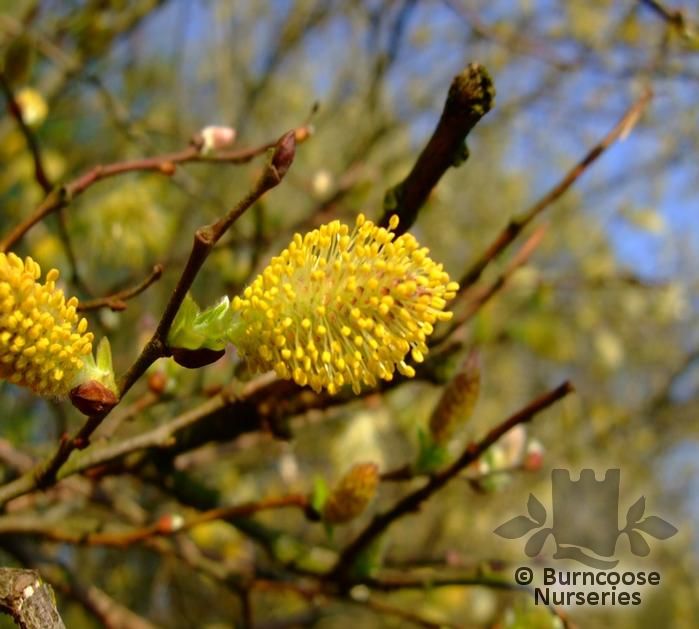Plants by mail order since 1984, over 4100 plants online today
Nursery & Gardens open: Mon - Sat 8:30 - 17:00 & Sun 10:00 - 16:00
Pop up café: open weather dependent
- Shop Now
- Burncoose Specialities
- This Month
- Offers & Promotions
- RHS Chelsea Flower Show 2024
- 40 years at Burncoose
- Engage With Us
- Information, Help & Advice
- About Us & Our Services
- Terms & Conditions
- Log In / Register
SALIX cinerea
Commonly known as Grey sallow, Grey willow
Grey underside to the leaves
Further Reading....
-
DeciduousSoft, silvery leaves
-
 Height3m (10ft)
Height3m (10ft) -
 Spread2m (6½ft)
Spread2m (6½ft) -
Tall ShrubShrubby, covered in fine grey down which remains on twigs until second season.
-
 Very hardyHardy in the severest continental climates including exposed upland locations in the UK. Plant can withstand temperatures < -20 (-4°F)
Very hardyHardy in the severest continental climates including exposed upland locations in the UK. Plant can withstand temperatures < -20 (-4°F) -
 Full sun
Full sun
SALIX cinerea
-
Additional Features
 Good to knowUK native. Similar to S. caprea. Possibly the tree of WB Yeats 'Salley Gardens'. A bit scruffy but brilliant for nectar
Good to knowUK native. Similar to S. caprea. Possibly the tree of WB Yeats 'Salley Gardens'. A bit scruffy but brilliant for nectar Pests & DiseasesAphids, caterpillars, leaf beetles, sawflies, willow scale, anthracnose, honey fungus, rust.
Pests & DiseasesAphids, caterpillars, leaf beetles, sawflies, willow scale, anthracnose, honey fungus, rust. Place of originEurope to western Asia.
Place of originEurope to western Asia. -
Garden Location/ConditionsBorderSuitable for a large shrub border
-
HardinessFully hardy
-
Leaf margin
 Serrulate
Serrulate(see photos above) -
Leaf shape
 Obovate
Obovate(see photos above) -
Pruning group
 Pruning group 1Suitable for: Deciduous and evergreen trees, and some deciduous shrubs.
Pruning group 1Suitable for: Deciduous and evergreen trees, and some deciduous shrubs.
Pruning: Minimal pruning required. Prune wayward or crossing branches to maintain a healthy framework.
When: When dormant in the late winter/early spring. Some in the summer/autumn to prevent bleeding of sap.
-
Seasonal InterestSpring
-
Soil ConditionsTolerates allExcept chalkWet or boggy soil
-
Wildlife
 Bee friendly
Bee friendly
Jan
Feb
Mar
Apr
May
Jun
Jul
Aug
Sep
Oct
Nov
Dec
Salix - Growing Guide
|
3m (10ft)
|

|

|
|
2m (6½ft) |
Useful extras...

Fertilisers & Feeds - Vitax
Q4 Pelleted Fertiliser
A useful fertiliser suitable for use on a wide variety of plants. Q4 provides all the nutrients and trace elements essential for vigorous growth, abundant flowering and ripening of fruit.
3 options from £6.00

Fertilisers & Feeds - Empathy
Afterplant - Grow Your Own
AFTER PLANT GROW YOUR OWN seaweed is ready to use liquid concentrate that was specially formulated be used on all edible plants.
Only £8.00

Fertilisers & Feeds - Empathy
Afterplant - Tomatoes
AFTER PLANT TOMATO FEED Liquid Concentrate with Bio stimulant is a high potash liquid concentrate containing seaweed extract, plant derived amino acids and other nutrients specifically formulated to benefit tomatoes and greenhouse plants.
Only £8.00

Fertilisers & Feeds - Empathy
Rootgrow mycorrhizal fungi
Recommended by the RHS. Contains Rootgrow™ mycorrhizal fungi. Suitable for all trees and shrubs (except rhododendrons, azaleas, heathers, cranberries and blueberries)
3 options from £3.00

Fertilisers & Feeds - Empathy
Rootgrow Ericoid mycorrhizal fungi
This specially adapted Rootgrow™ mycorrhizal fungi will boost the growth of acid-loving plants like rhododendrons, azaleas, heathers and blueberries.
It contains ericoid and arbuscular mycorrhizal fungi, which are found in poor acidic soils where ericaceous plants naturally grow.
Only £7.50

Fertilisers & Feeds - Empathy
All-purpose Seaweed Stimulant
All-purpose organic concentrated seaweed feed that is a ready to use, derived from sustainable harvested kelp, that can be used on all outdoor and indoor plants, except acid loving plants.
Perfect used in conjunction with Rootgrow™.
Only £7.50





















